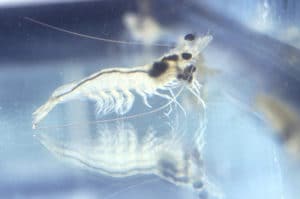 One of the fastest growing global foods is also one of its most vulnerable. Without an adaptive immune system, the Pacific white shrimp, Litopenaeus vannamei, rely on cellular and humoral defenses, such as the release of antimicrobial peptides, in their battle against invading microbes and pathogen infections. A battle they’re losing, leading to massive mortality and devastating economic losses.
One of the fastest growing global foods is also one of its most vulnerable. Without an adaptive immune system, the Pacific white shrimp, Litopenaeus vannamei, rely on cellular and humoral defenses, such as the release of antimicrobial peptides, in their battle against invading microbes and pathogen infections. A battle they’re losing, leading to massive mortality and devastating economic losses.
A full-length transcriptome analysis using the PacBio Iso-Seq method has resulted in an isoform-level reference transcriptome that is shedding new light into the shrimp’s innate immune system, providing hope for the shrimp aquaculture industry. One of the most economically important shrimp species in the global aquaculture industry, Pacific white shrimp global production grew from 2,688,901 tons in 2010 to 4,168,417 tons in 2016, according to The Food and Agriculture Organization of the United Nations. However, farmed shrimp supplies are under significant threat from three major shrimp pathogens: acute hepatopancreatic necrosis disease (AHPND), white spot syndrome virus (WSSV) and bacteria in the genus Vibrio.
By interrogating the transcriptome of the vulnerable species, a team of scientists from the Guangdong Institute of Applied Biological Resources in China were able to identify more than 5,000 full-length transcripts involved in its innate immune system, including nine immune-related processes, 19 immune-related pathways and 10 other immune-related systems. They also found wide transcript variants, including toll-like receptors (TLRs) and interferon regulatory factors (IRFs), which increased the number and function complexity of immune molecules.
Reporting in Fish and Shellfish Immunology, Chen Jinping and first author Zhang Xiujuan described how they combined PacBio isoform sequence (Iso-Seq) analysis and Illumina paired-end short read methods to discover 72,648 nonredundant full-length transcripts (unigenes) with an average length of 2,545 bp from five main tissues: the hepatopancreas, cardiac stomach, heart, muscle, and pyloric stomach. The team turned to targeted isoform sequencing due to the difficulty they would have faced trying to sequence the entire L. vannamei genome, which currently has no reference. The genome is large and contains highly repetitive sequences; previous attempts to characterize its transcriptome using short reads restricted the yield of full-length cDNA molecules, the authors wrote.
“Using short read RNA-Seq strategies, extensive alternative prediction is impractical and a high variability of isoforms expression quantification is impossible in shrimp without a true genome reference,” “The PacBio Iso-Seq strategy provides the convenience of finding more numbers of AS events of genes in many species, including reference-free species.”
The scientists used homology-based cDNA cloning to amplify full-length sequences of the shrimp’s immune genes to generate a high-confidence isoform dataset that was sequenced at Nextomics Biosciences in Wuhan, China. After annotating these full-length transcripts with well-curated databases, long noncoding RNAs (lncRNAs) and alternative splicing events were characterized.
Using the full-length isoform transcripts yielded from the SMRT Iso-Seq analysis as reference sequences, the unigene expression levels among the various tissues of L. vannamei were further analyzed based on short read datasets generated by the Illumina sequencing platform.
“Understanding the innate immune system of shrimp and revealing their immune responses against invading pathogens might contribute to developing strategies for the prevention and treatment of these diseases, which is essential for the shrimp aquaculture industry,” the authors wrote.
This survey of transcript variants and expression profiles of the immune-related molecules of L. vannamei have contributed to a comprehensive insight into the immune system, and will provide a valuable resource for geneticists and the commercial sector alike, they concluded.